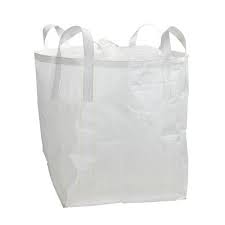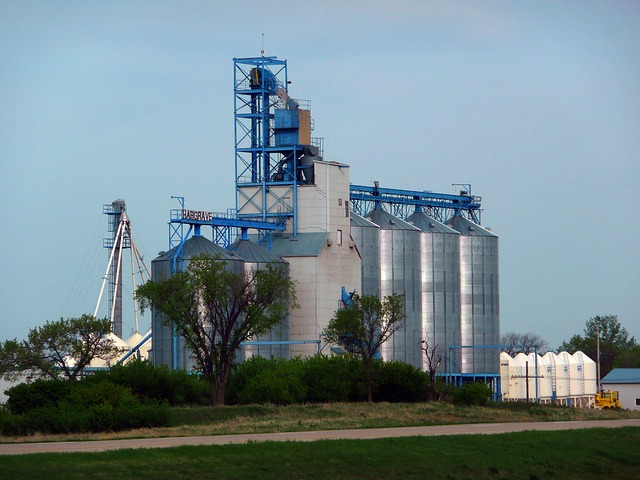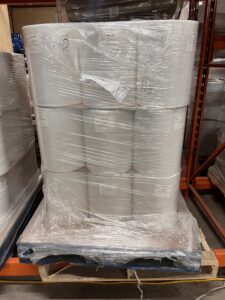Flexible Intermediate Bulk Containers (FIBCs), commonly known as bulk bags or tote bags, are essential in industries requiring efficient and safe transport of dry, flowable products.
Bulk bags are made from woven polypropylene and can handle some serious loads, making them useful in agriculture, construction, chemical, and even the pharmaceutical industries.
Here, we’ll go over the types of bulk bags you’ll run into, specialized features, and applications to help you choose the right Flexible Intermediate Bulk Container tote for your needs.
Why use a Flexible Intermediate Bulk Container?

Who for, or why even, use these bags in the first place? Well, strap in:
- Simplicity: They’re about as simple a bulk packaging solution as you can imagine, and yet they are in many cases the most efficient and reliable options. As the saying goes: “good AND simple – twice as good.”
- Durability: Even with a low upfront cost, FIBC totes generally last years under normal circumstances, and reinforced bulk bags can last longer. This means you’ll spend less money over the years for the same utility.
- Cost efficiency: Pretty much any flexible intermediate bulk container is reusable. Additionally, FIBCs can be tremendously inexpensive compared to other bulk packaging solutions, like metal bins.
- Eco-friendly: Tote bags are often recyclable and help reduce the environmental impact thanks to requiring less material in their construction.
- Versatile: Flexible intermediate bulk bags are used in industries ranging from agriculture and food processing to chemicals and construction.
Types of FIBC Bags
Bulk bags are categorized mainly based on their electrostatic properties, which can be crucial for safely transporting materials that are flammable or combustible.
Electrostatic refers to stationary electrical charges. These charges can accumulate inside the bag due to the friction of the bulk materials with the bag. If too much charge accumulates, it can suddenly discharge and cause a fire, even in the case of tiny sparks. This is the same static electricity that causes your hair to stand on end.
There are four primary types of FIBC bags.
Type A Bulk Bags
Made from polypropylene — a type of plastic polymer — these bags do not have any static protection. As such, they’re only used for transport of non-flammable materials. They look just like standard packaging bags, lacking any coating or conductive threads that make other FIBC bags recognizable. They are often used for construction materials or transport of grain.
- Material: These FIBC bags are generally made of woven polypropylene.
- Electrostatic Protection: None.
- Applications: Suitable for non-flammable products like food products, grains, sand, and minerals. These bags are the most basic and economical option but must not be used in flammable environments.
Type B FIBC Bags

These flexible intermediate bulk containers are also made from the same plastic and won’t offer static protection. However, they’re designed to prevent small energetic discharges — commonly called “low voltage” discharges. They look like Type A FIBC bags and are ideal for transporting dry powders. They come in various sizes, but they are generally big bags that can carry up to a metric ton.
- Material: Type B FIBCs are made from polypropylene with low breakdown voltage.
- Electrostatic Protection: Prevents small energetic discharges.
- Applications: Suitable for transporting dry, flammable powders that do not require significant electrostatic protection. These are safer than Type A in certain conditions but still not suitable for environments with flammable gases or dust.
Type C Bulk Bags
These flexible intermediate bulk container bags are the first example of conductive FIBCs that actually dissipate incendiary sparks. Designed with interwoven conductive threads that require grounding during use to dissipate static electricity. You can recognize them because they feature grounding tabs and metal threads interwoven in the material. Basically, any static that starts to build will travel through the conductive threads and dissipate into the ground before becoming dangerous.
- Material: Made from non-electrically conductive fabric interwoven with conductive threads.
- Electrostatic Protection: Requires grounding but dissipates static charges.
- Applications: Ideal for transporting flammable chemicals and materials when grounded properly. Type C FIBCs are used in industries where static electricity poses a significant risk.
- Concerns: Human error during use can make them useless. These bags must be grounded, or they will not prevent propagating brush discharges.
Type D Bulk Bags
Up to now, none of the flexible intermediate bulk containers that we’ve mentioned were fully static-resistant. Type D bags are made from anti-static fabrics and prevent static discharges without grounding. They are used for transporting bulk materials like chemicals, hazardous materials, or even food products like starch which, believe it or not, is extremely flammable.
- Material: Made from anti-static fabrics and conductive grids.
- Electrostatic Protection: Provides complete electrostatic protection.
- Applications: Best for transporting highly flammable products in environments where grounding is impractical or impossible. These bags offer the highest level of safety.
Specialized Flexible Intermediate Bulk Container Bags
A bulk bag can come in many forms depending on its intended use. Here are some examples of bulk container bags designed with a specific purpose in mind.

Bottom Discharge Bags
These bags come with a spout or flap at the bottom which makes emptying through the floor easy. This design is intended for frequent unloading, such as in agriculture settings where grains must be constantly moved.
Baffle Bags
This kind of bulk bag includes internal panels known as baffles that maintain the bag’s shape when filled. These bags are optimized for palletizing and stacking. The idea is to reduce the risk of spillage.
Ventilated FIBCs
This bulk bag is made with breathable fabric that allows air to circulate freely inside and out. This is the perfect solution for industries that transport perishable goods that degrade when humidity accumulates.
For example, ventilation prevents fruits from spoiling; the same principle applies to firewood and many vegetables.
Lined FIBCs
Lined with polyethylene or other materials that provide some more complete moisture protection, this type of bulk bag is often used to handle fine powders or chemicals that cannot be exposed to moisture or contamination.
Relevant FIBC Facts You Should Know
- Load Capacity: A flexible intermediate bulk container can hold between 500kg, or 1100 pounds and 2000kg, or 4400 pounds.
- UV Protection: If you plan on leaving your flexible intermediate bulk bags in the sunlight, know that many models are treated with UV inhibitors, protecting them against sun damage for a period – though not forever.
- Customizable: There are many discharge options, designs, and features you can opt for when buying a flexible intermediate bulk bag.
- Lifting Options: FIBC tote bags include many available lifting options, like single-loop, double-loop, and four-loop designs, depending on what lifting equipment you already own.
- Discharge Mechanisms: Beyond bottom spouts, you can find duffle tops, open and closed tops, and many other filling options.
Order Bulk Bags Online Quick and Easy
Looking to step up your game using premium bulk bags? We’ve been a leading supplier in Canada for decades, and we’re now sell FIBC totes in the States, too!
Discover our roster of bulk FIBC bag options and order yours online today. You can also contact us directly for larger orders or for questions and concerns.
FAQs
What materials are FIBCs made from?
Most FIBC bags are made from plastic. Most use a polymer called polypropylene because of its durability and it’s ease as a flexible fabric. It packs down to the size of a watermelon when not in use! Some FIBCs come with polyethylene liners — a different type of plastic — or conductive threads made of metal.
Are FIBCs reusable?
Yes, FIBC totes are reusable. Keep in mind, however, that these deteriorate more quickly when used to transport rough materials such as construction debris. Always inspect them for damage before reuse.
How are FIBCs tested for safety?
Broadly speaking, FIBC bags must comply with guidelines such as ISO 21898. They are tested for load capacity, stability, and static protection.




